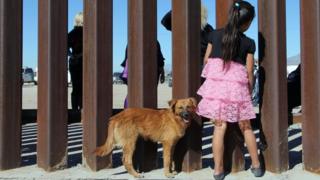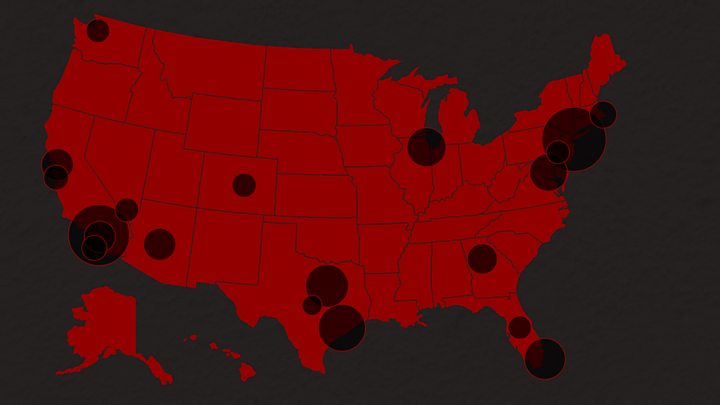 Image copyright
Getty Images
Image copyright
Getty Images
President Donald Trump says a federal government shutdown will continue until he receives billions in funding to address a "humanitarian and security crisis at our southern border".
As the federal government shutdown pushes through its third week, an estimated 800,000 federal employees are going without pay, with about half of those - including airport security and federal prison guards - still expected to turn up for work. If no agreement is reached by Friday, workers will miss their first paycheck due to the shutdown.
Nevertheless, President Trump is adamant that the shutdown is necessary to force Congress to approve $5.7bn (£4.5bn) for his long-promised border wall, a cornerstone of his 2016 campaign. He plans to address the nation from the Oval Office on Tuesday night to make his case to the American people once again.
Democrats, newly in control of House, are blocking the president's request and say the administration's immigration policies and rhetoric amount to a "manufactured crisis". So what's really happening on the US-Mexico border?
How many people are crossing the border illegally?
While it is impossible to say for certain how many people enter the US via the southern border illegally each year, apprehensions made by US Customs and Border Protection agents provide one measure.
So far in fiscal year 2019, which include the months of October and November, there have been 102,857 arrests at the border, a marked increase from the same time last year.
However, in the past two years, there has not been a dramatic surge in the number of apprehensions at the border, as compared with the Obama years.
CBP made a total of 396,579 apprehensions on the Southwest border in fiscal year 2018, and 303,916 in 2017.
In President Barack Obama's final year in office, there were 408,870 apprehensions.
If we look at the wider picture, there has been a sharp fall in the number of people arrested in the last 10 years.
So, is there a current "crisis" of illegal immigration on the southern border?
"No," says Jacinta Ma, director of policy and advocacy for the National Immigration Forum. "Even with the rise in apprehensions over the last year, it's way down from the early 2000s."
Do most illegal entries take place at the southern border?
Illegal border crossings are not limited to the southern border of course - in 2017, for example, there were also 3,027 illegal apprehensions from along the Canadian border and 3,588 from the coastal border.
While cross-border migrants often make headlines, the largest number of illegal migrants settling in the US each year are the people who stay in the country after their visas expire.
According to the most recent reports by the Department of Homeland Security and the Center for Migration Studies, the number who overstayed their visas has outnumbered those who crossed the border illegally every year since 2007. Canadians make up the largest group of these illegal migrants, followed by Mexicans.

In 2016, there were a total of 739,478 overstays, compared to 563,204 illegal border crossings.
It's also important to note that, according to the Pew Research Center, overall the number of immigrants living in the US illegally has actually declined since 2007, in large part to a dip in the number of people coming from Mexico. Apprehensions at the southwest border peaked in 2000, at 1.64m.
In total, Pew estimates that in 2016, there were 10.7m unauthorised immigrants living in the US.
How many people are attempting to cross legally?
Apprehension numbers released by the CBP include asylum seekers (a person who applies for refugee status at a US port of entry or from within the country).
In fiscal year 2018, 92,959 people made claims of credible fear and asked for asylum at the border. That's a pretty big jump from fiscal year 2017, when 55,584 claims were made.
Kate Jastram, senior staff attorney for the Center for Gender and Refugee Studies at the University of California Hastings College of the Law, says that families fleeing violence in Central America began to make up a much larger part of border crossings beginning in 2014. She says that has more to do with conditions in those countries than any immigration policy implemented by the Trump administration.

"Single men from Mexico were by and large not seeking asylum, they were looking for work," says Jastram. "[Now] we have families and children specifically seeking protection."
In November, a caravan of 7,000 migrants arrived at the US-Mexico border, many claiming to be fleeing violence in countries like Honduras, Guatemala and El Salvador. Mr Trump labelled the caravan an "invasion".
Overall, the rate of asylum denials is on the rise in the US, and has been for the past six years, with a slight uptick since the beginning of the Trump administration.
The most recent report, 2016, shows a total of 115,399 applied and 20,455 individuals were granted asylum to stay in the United States.
What has the Trump administration done to address all this?
Over the past two years, President Trump and his administration have tried a variety of deterrent measures to stop crossings at the US-Mexico border, which have affected both illegal entrants and asylum seekers.
Most recently, US Department of Homeland Security announced that asylum seekers caught crossing illegally must wait across the border in Mexico for adjudication of their cases, a shift in policy that DHS Secretary Kirstjen Nielsen called "catch and return".
Border officials have also decreased the number of asylum cases they will process each day, a strategy called "metering".
In June, then-Attorney General Jeff Sessions announced that claims of domestic and gang violence would no longer qualify as grounds for asylum in the US - last month, a federal judge ruled that there was "no legal basis" for such a policy change.
Most controversially, in spring, thousands of migrant children were separated from their parents at the border as a part of a "Zero Tolerance Policy" that referred anyone found crossing illegally for prosecution.
Between 5 May and 9 June, 2,342 children were taken from their parents and held in separate government centres, according to the Department of Homeland Security.
The separations touched off a firestorm of condemnation and protest, until Mr Trump reversed the order in June.
Last week, Mr Trump said he was considering declaring a "national emergency" in order to force through his border wall funding - legal and constitutional scholars are divided on whether or not the president has the power to do such a thing, or if the laws exist to accomplish what he wants.
If he does, court challenges or even a challenge directly from Congress could follow.
Adam Schiff, the House intelligence committee chairman, told CNN: "If Harry Truman couldn't nationalise the steel industry during wartime, this president doesn't have the power to declare an emergency and build a multibillion-dollar wall on the border."
What about terrorists?
It was an eye-catching claim from the White House press secretary.
"Last year alone there were nearly 4,000 known or suspected terrorists that CBP picked up that came across our southern border," Sarah Sanders told Fox and Friends on Friday.
That is simply not true. Even her colleague Kellyanne Conway later called it "an unfortunate misstatement".
So where did that figure come from?
A White House briefing report on immigration says 3,755 known or suspected terrorists were prevented from entering the US in the fiscal year 2017.
But that includes terror suspects who have been stopped at any US border, and the vast majority are stopped at airports.
"The debate is over a land border wall. To include airport statistics is irrelevant and misleading," says Todd Bensman from the Center From Immigration Studies, a think tank which favours lower immigration.
Bensman, a former counterterrorism intelligence manager who worked at the Texas border, analysed data from a "reliable intelligence community source" and concluded that more than 100 migrants on terror watchlists were apprehended at the southern border between 2012 and 2017, amounting to an average of around 20 a year.
Data from NBC News seems to support his assertion.
It learnt that in the first half of 2018 only six immigrants on the terror watchlist were stopped at the southern border
Bensman cites as yet unpublished data in which he claims 90 people who entered Europe as migrants during 2014-18 were later found to have been involved in a terror attack or apprehended before one.
"Ninety sounds like a lot, but there were two million refugees who entered Europe. It's a fraction, but it still has political consequences," he argues.
But no-one who has crossed the US southern border illegally from 1975 to the end of 2017 has been responsible for a terror attack on US soil, according to David Bier and Alex Nowrasteh of the Cato Institute.
Seven so-called "special interest aliens" were convicted of planning an attack on US soil, during that time. But that category includes any visitor from a country deemed by the US intelligence community as a risk. In the past it has been a list of 50.
Reporting by Jessica Lussenhop and Rajini Vaidyanathan